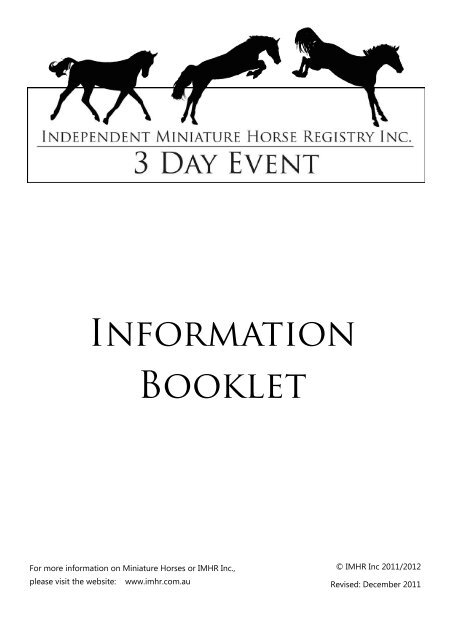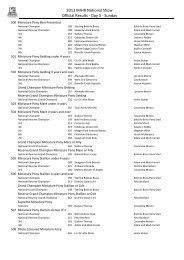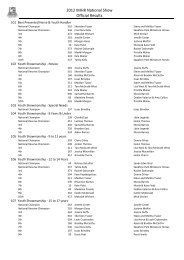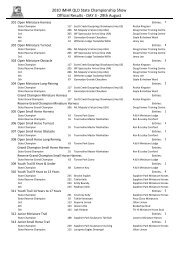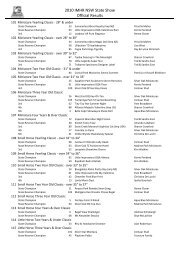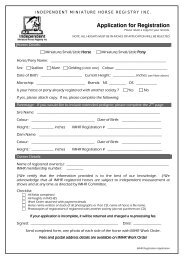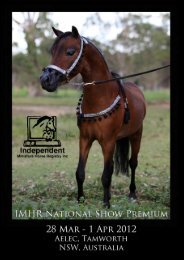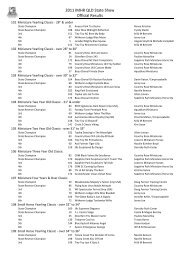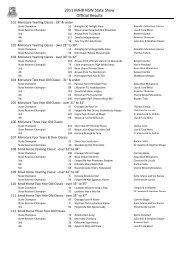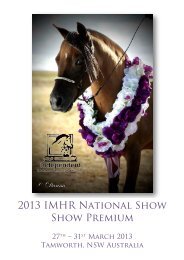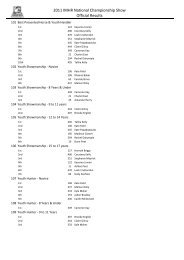3DE-Information-Book.. - Independent Miniature Horse Registry Inc.
3DE-Information-Book.. - Independent Miniature Horse Registry Inc.
3DE-Information-Book.. - Independent Miniature Horse Registry Inc.
Create successful ePaper yourself
Turn your PDF publications into a flip-book with our unique Google optimized e-Paper software.
<strong>Information</strong><br />
<strong>Book</strong>let<br />
For more information on <strong>Miniature</strong> <strong>Horse</strong>s or IMHR <strong>Inc</strong>.,<br />
please visit the website: www.imhr.com.au<br />
© IMHR <strong>Inc</strong> 2011/2012<br />
Revised: December 2011
Table of Contents<br />
Event Overview 3<br />
Day 1—Dressage in Hand 4<br />
Dressage In Hand Pattern 5<br />
Dressage in Hand Score Sheet 6<br />
Day 2—Show Jumping 7<br />
Day 3—Cross Country Obstacle 8<br />
Cross Country Obstacle Course 9<br />
Important <strong>Information</strong><br />
Eventing is physically demanding on both horse and handler. Please consider your horse’s<br />
fitness level especially if your horse is entered in multiple performance events.<br />
In the interest of competing horses, competitors are advised to warm up their horses in<br />
the marshalling area prior to commencing the cross country/obstacle course.<br />
The Judge may eliminate any horse they believe is unfit to continue in any of the three<br />
disciplines.<br />
2
Event Overview<br />
To be held over three days as part of the 2012 National<br />
Show. The rules/point system is based on Equestrian<br />
Australia (formerly EFA) rules adjusted for miniature<br />
horses.<br />
$500 first prize<br />
State of Origin trophy<br />
A true test of fitness, versatility and<br />
obedience<br />
Open to senior horses only - mares, geldings and<br />
stallions aged 3 years and over (actual age).<br />
Competitors must be aged 13 or over on the first day of<br />
the event.<br />
How it works<br />
Eventing is a test of your horse’s fitness, athleticism,<br />
stamina and obedience. It consists of three phases:<br />
1 x Dressage In Hand test<br />
1 x Show Jumping round<br />
1 x Cross country/Obstacle course<br />
The winner is the competitor with the highest total score<br />
across all three components. An explanation of each<br />
component and how it is scored is provided in this guide.<br />
Each individual competitor may enter only one horse.<br />
The same combination of horse and handler will<br />
complete all three phases once only – so choose your<br />
best horse!<br />
The horse must be handled by the same competitor for<br />
each of the three (3) phases. As the Show Jumping phase<br />
will be held as part of the standard Show Jumping class<br />
(performance program), horses that are also entered in<br />
Show Jumping may be handled by a different person for<br />
second and subsequent rounds of Show Jumping only.<br />
State of Origin – the challenge is on !<br />
As part of the IMHR inaugural Three Day Event, a<br />
perpetual state-based trophy will be awarded. The results<br />
of the three highest scoring horses from each state (state<br />
of current residence of horse) will be totalled to<br />
determine the winning state.<br />
Is your state Australia’s No. 1 for eventing?<br />
Enter to find out!<br />
Equipment<br />
No bits or whips are to be used in any of the three<br />
phases.<br />
Dressage Phase<br />
Marks are allocated for presentation.<br />
It is recommended that<br />
horses complete the dressage<br />
test in a leather/webbing<br />
halter (as per pic on left).<br />
Browbands may be worn.<br />
Halters must sit flat against<br />
the horse’s nose - no<br />
buckles/knots are to rest on<br />
the horse’s noseband.<br />
Rope halters must not be used.<br />
No leg bandages in dressage.<br />
The horse may have its mane/tail braided.<br />
Handlers may choose between Western or English attire<br />
however all handlers must wear safe, covered footwear<br />
AND gloves. Hats are optional.<br />
Cross Country/Obstacle & Show Jumping<br />
Normal performance gear and handler attire may be<br />
used.<br />
Leg bandages/ bell boots may be worn.<br />
3
Day 1—Dressage in Hand<br />
(Average time 2 – 3 minutes)<br />
Each movement in the test is scored on a scale from 0 to<br />
10 as below:<br />
10 Excellent, 9 Very Good, 8 Good, 7 Fairly Good, 6 Satisfactory,<br />
5 Sufficient, 4 Insufficient, 3 Fairly Bad, 2 Bad, 1<br />
Very Bad, 0 Not Executed.<br />
Points are awarded for:<br />
- Grace, flexibility, and obedience;<br />
- Smoothness of transitions from one gait to another;<br />
- The horse’s ability to maintain an even rhythm at each<br />
gait, and<br />
- The horse’s ability to move forward with impulsion<br />
(‘active’ but not uncontrolled).<br />
Course errors (performing an incorrect movement) incur<br />
penalties: 1 st error – 5 points; 2 nd error – 10 points; 3 rd<br />
error – 15 points; 4 th error – elimination (a whistle will be<br />
blown signalling elimination).<br />
There are 8 movements, giving each competitor a score<br />
out of 80. An additional mark (out of 10) is awarded for<br />
presentation of horse and handler plus an additional<br />
mark (out of 10) for overall impression and suitability to<br />
give a total score out of 100.<br />
What does the dressage arena look like ?<br />
TIPS<br />
Each competitor salutes the judge (located outside the<br />
arena at ‘C’) at the finish of the test. A salute involves<br />
lowering your left arm by your side and nodding your<br />
head to the judge. It is not a military style salute. Your<br />
horse should stand parallel to you at the salute (points<br />
are awarded if the horse stands square though you cannot<br />
square the horse yourself as you would in a halter<br />
class).<br />
You will gain points by using the arena to its maximum<br />
size. Push your horse deep into each corner rather than<br />
cutting corners, and aim to stay right on the arena<br />
boundaries. Points will be deducted if you or your horse<br />
step outside the arena.<br />
There is no lungeing involved in the test. The handler<br />
remains at the horse’s left shoulder at all times.<br />
A ‘working trot’ is a strong energetic trot – though not<br />
an extended trot.<br />
A ‘free walk’ requires the horse to have a longer lead to<br />
allow for stretching of the neck while maintaining an<br />
active pace without breaking stride.<br />
Before practising the test with your horse it is a good<br />
idea to walk through the test yourself.<br />
You can choose to memorise the test or have a ‘caller’,<br />
who calls each movement to you from the side of the<br />
arena. (It helps if the caller familiarises him/herself with<br />
the test first.)<br />
4
Day 1—Dressage in Hand<br />
G<br />
G<br />
G<br />
G<br />
G<br />
G<br />
Centre line at A to G—Working Trot<br />
G<br />
G<br />
Halt and Salute at G<br />
Leave arena—Loose Lead<br />
5
Day 1—Dressage in Hand<br />
Competor number:<br />
Movement What the judge is looking for Score /10<br />
1 AX Enter at medium walk Straightness on centre line, transions,<br />
quality of walk<br />
2 XC Working trot Quality of trot<br />
3 C Full circle right 10 metre<br />
diameter at working trot<br />
4 CXA Medium walk serpenne through<br />
X<br />
5 A Full circle right 10 metre<br />
diameter at working trot<br />
Roundness of circle<br />
Quality of walk<br />
Roundness of serpenne<br />
Roundness of circle<br />
6 AXC Working trot up centre line to G Quality of trot<br />
Straightness on centreline<br />
7 G Halt and salute Quality and straightness of halt<br />
8 C Track right and exit arena on<br />
loose lead<br />
Quality of free walk<br />
Test Score:<br />
Presentaon of horse and handler (out of 10):<br />
Overall impression and suitability (out of 10):<br />
Less penales: 1 st – 5 points, 2 nd – 10 points, 3 rd – 15 points, 4 th Eliminaon<br />
TOTAL Score:<br />
6
Day 2—Show Jumping<br />
This phase consists of six (6) jumps, and will be<br />
conducted as part of the performance program Show<br />
Jumping class. This ensures that each horse completes a<br />
course that is height appropriate. Current IMHR show<br />
jumping rules apply (refer to the IMHR Performance<br />
Handbook).<br />
Scoring:<br />
One refusal/run out – 4 penalty points (points<br />
deducted from your overall tally)<br />
Two refusals/run out – 8 penalty points<br />
Knockdown of jump—3 penalty points<br />
Three refusals/run out – Elimination<br />
Only the first round of show jumping will count<br />
towards your horse’s <strong>3DE</strong> score.<br />
If you have a clear round AND you are competing in<br />
Show Jumping as part of the performance events, your<br />
horse will need to continue on to the next round of Show<br />
Jumping though this will not count towards your final<br />
Three Day Event score. A different handler may be used<br />
for second and subsequent Show Jumping rounds only.<br />
Your score will be placed on the competitor score<br />
board (located outside the marshalling area) on<br />
completion of this phase providing a running tally<br />
heading into the next phase.<br />
Remember, your horse’s performance will contribute to<br />
your State of Origin score, so it is important to compete<br />
in the each phase even if your individual score puts you<br />
out of contention for the top placings at the end of any<br />
phase.<br />
Important!<br />
Competitors who travel their horse at reckless<br />
speed or endanger their horse in any way will<br />
be instantly eliminated.<br />
Competitors attempting to ‘drag’ horses<br />
over a jump from the opposite side of the<br />
jump in any event will be instantly<br />
eliminated.<br />
Please note: The <strong>3DE</strong> entry fee covers only the first<br />
round of Show Jumping to add to your <strong>3DE</strong> score. If you<br />
wish to compete in the full round of Show Jumping, you<br />
must pay the entry fee for that class in addition to your<br />
<strong>3DE</strong> entry fee.<br />
7
Day 3—Cross Country Obstacle<br />
To be held in the main indoor arena at AELEC.<br />
The cross country phase will be no more than 250<br />
metres in length.<br />
This phase is a test of your horse’s endurance and<br />
versatility and combines both trail and hunter obstacles.<br />
A total of 15 elements including brush fences, stone<br />
walls, a water jump, logs, an arbour (or arch) and a<br />
bridge must be attempted in a set pattern.<br />
Each obstacle will be clearly numbered and a pattern<br />
made available to competitors on the day prior to this<br />
phase. The maximum jump height is 16 inches – all<br />
horses, whether miniature horse, small horse or little<br />
horse, will complete the same jumps.<br />
Timing<br />
The cross country phase is a timed event, however<br />
additional points are not awarded for the fastest time<br />
over the course. Competitors are required to<br />
complete the course within minimum and maximum<br />
time limits. These times will be announced prior to<br />
the commencement of the cross country phase.<br />
Please note: Exhibitors may work at the gait(s) they<br />
feel most comfortable with (walk, trot, canter or a<br />
combination).<br />
One whistle will blow when the competitor has reached<br />
the minimum time. Two whistle blows will signify that the<br />
maximum time has been reached. On hearing two<br />
whistles the competitor must leave the course<br />
immediately, exiting through the finish cones - only<br />
points earned on completed obstacles to the point of the<br />
final whistle blowing will count towards the final score.<br />
Scoring:<br />
Points are earned based on the style, grace and<br />
responsiveness of the horse as it negotiates each<br />
obstacle. All obstacles have equal points (marked out of<br />
10) and scoring is at the judge’s discretion.<br />
Penalty points are fixed for certain errors:<br />
Jump penalties:<br />
One refusal/run out – 4 penalty points;<br />
Two refusals/run outs – 8 penalty points;<br />
Three refusals/run outs – Elimination (denoted by 2<br />
whistle blows.)<br />
Knockdown of jump: 3 penalty points per jump ;<br />
Three knockdowns – Elimination (denoted by 2 whistle<br />
blows.)<br />
Completing course under the minimum time – 5 penalty<br />
points per second<br />
Important!<br />
Competitors who travel their horse at reckless speed or<br />
endanger their horse in any way will be instantly<br />
eliminated.<br />
Competitors attempting to ‘drag’ horses over a jump<br />
from the opposite side of the jump in any phase will<br />
be instantly eliminated.<br />
8
Day 3—Cross Country Obstacle<br />
Sample Course Layout (approx. length 250 metres):<br />
Sample ‘Arch’<br />
Please note: Both horse and handler need to<br />
go through the arch.<br />
9


